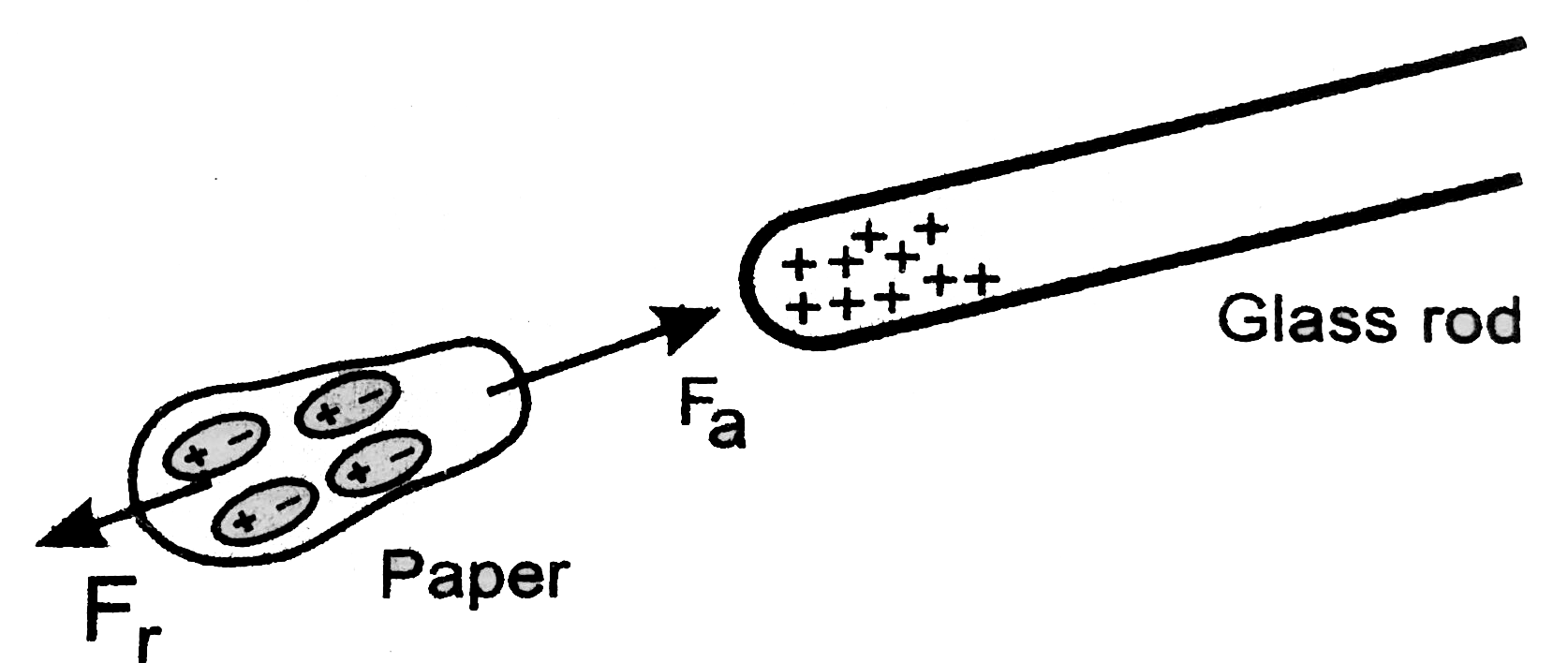Why does a charged glass rod attract a piece of paper ?
Paper is a dielectric. When a positively charged glass rod is brought near it, atoms of paper get polarised , with center of negative charge of atoms coming closer to glass rod. Therefore, force fo attraction between glass rod and piece of paper becomes greater than the force of repulsion between the glass rod and the piece of paper towards the glass rod.

Similar Questions
Knowledge Check
When a charged rod is brought near small bits of paper, the small bits will
ABe repelled by the rodBStick firmly to the rodCAttach itself to the rod at first and then fly offDRemain unaffected.
Akshay and Sauranh are the students of class IX. They have recently studied the chapter on structure of atom in the class. Both Akshy and Saurabh were performing some activities in the science laboratory. Akshy took a plastic comb and rubbed it in his dry hair. When he brought this plastic comb (rubbed in dry hair) near tiny pieces of paper, the comb attracted the pieces of paper towards it. Mean while, Saurabh took a glass rod and rubbed it with a piece of silk cloth. When he brought this glass rod (rubbed with silk cloth) near the tiny pieces of paper, the glass rod also attracted the pieces of paper towards it (just like the plastic comb). Akshy and Saurabh had studied an instrument called electroscope in class VIII. So, they decided to make use of a positively charged electroscope having diverged leaves (or opened up leaves) in their activity. Akshy took the plastic comb (rubbed in dry hair) and touched the metal top of positively charged electroscope with it. This made the diverged leaves of electroscope to fold up. Saurabh then tool the glass rod (rubbed with silk cloth) and touched the metal top of another positively charged electroscope with it. This made the diverged leaves of the electroscope to diverge (or open up) even more. Askshy did not understand the various conclusions which could be drawn from all these observations. Saurabh explained him everthing very clearly.
(a) What conclusion can be drawn from the observation that a plastic comb rubbed in dry hair and a glass rod rubbed with silk cloth, both attract tiny pieces of paper ?
(b) What do the above observations tell us about the atoms present on plastic comb and glass rod ?
(c) (i) What conclusion do you get from the observation that when a plastic comb rubbed in dry hair is touched with the metal top of a positively charged electroscope, then its diverged leaves fold up ?
(ii) What conclusion do you get form the observation that when a glass rod rubbed with silk cloth is touched with the metal top of a positvely charged electrosope, then its leaves diverage even more ?
(d) What are the two types of electric charges present in atoms as shown by the above observations ? Name the subatomic particles which carry these charges.
(e) (i) Which electric charges are agained by a plastic comb on rubbing in dry hair ?
(ii) Which electric charge are lost by a glass rod on rubbing with silk cloth ?
(f) What values are displayed by Saurabh in this episode ?
View SolutionWhen a charged comb is brought near a small piece of paper, it attracts the piece. Does the paper, it attracts the piece. Does the paper become charged when the conb is brought near it ?
View SolutionA charged rod attracts bits of dry paper, which after touching the rod often jump away from it rapidly, Explain
View SolutionWhy does a plastic comb rubbed with dry hair attaract tiny pieces of paper ?
View SolutionWhy is it not possible to separate two pieces of paper joined by glue or gum?\
View SolutionWhy does a glass rod coated with wax not becomes wet when dipped in water?
View SolutionWhy does a plastic comb rubbed with dry hair attaract tiny pieces of paper ?
View Solution

